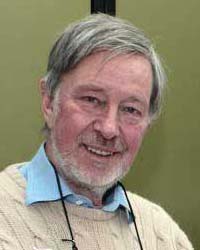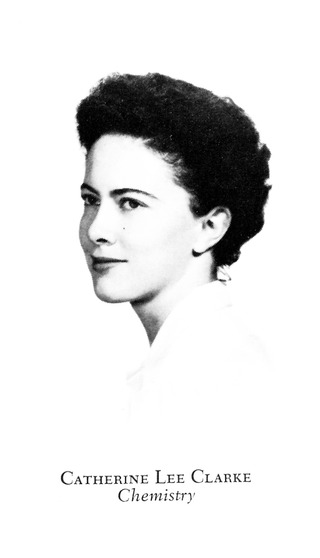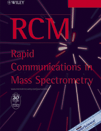
Electrospray ionization (ESI) is a technique used in mass spectrometry to produce ions using an electrospray in which a high voltage is applied to a liquid to create an aerosol. It is especially useful in producing ions from macromolecules because it overcomes the propensity of these molecules to fragment when ionized. ESI is different from other ionization processes since it may produce multiple-charged ions, effectively extending the mass range of the analyser to accommodate the kDa-MDa orders of magnitude observed in proteins and their associated polypeptide fragments.

In mass spectrometry, matrix-assisted laser desorption/ionization (MALDI) is an ionization technique that uses a laser energy absorbing matrix to create ions from large molecules with minimal fragmentation. It has been applied to the analysis of biomolecules and various organic molecules, which tend to be fragile and fragment when ionized by more conventional ionization methods. It is similar in character to electrospray ionization (ESI) in that both techniques are relatively soft ways of obtaining ions of large molecules in the gas phase, though MALDI typically produces far fewer multi-charged ions.
The thomson is a unit that has appeared infrequently in scientific literature relating to the field of mass spectrometry as a unit of mass-to-charge ratio. The unit was proposed by Cooks and Rockwood naming it in honour of J. J. Thomson who measured the mass-to-charge ratio of electrons and ions.
Soft laser desorption (SLD) is laser desorption of large molecules that results in ionization without fragmentation. "Soft" in the context of ion formation means forming ions without breaking chemical bonds. "Hard" ionization is the formation of ions with the breaking of bonds and the formation of fragment ions.

The Journal of Mass Spectrometry is a peer-reviewed scientific journal covering all aspects of mass spectrometry including instrument design and development, ionization processes, mechanisms and energetics of gaseous ion reactions, spectroscopy of gaseous ions, theoretical aspects, ion structure, analysis of compounds of biological interest, methodology development, applications to elemental analysis and inorganic chemistry, computer-related applications and developments, and environmental chemistry and other fields that use innovative aspects of mass spectrometry. It was established in 1968 as Organic Mass Spectrometry and obtained its current title in 1995.

Boris Aleksandrovich Mamyrin was a Soviet scientist best known for his invention of the electrostatic ion mirror mass spectrometer known as the reflectron.

Van Krevelen diagrams are graphical plots developed by Dirk Willem van Krevelen and used to assess the origin and maturity of kerogen and petroleum. The diagram cross-plots the hydrogen:carbon atomic ratio as a function of the oxygen:carbon atomic ratio.

Ambient ionization is a form of ionization in which ions are formed in an ion source outside the mass spectrometer without sample preparation or separation. Ions can be formed by extraction into charged electrospray droplets, thermally desorbed and ionized by chemical ionization, or laser desorbed or ablated and post-ionized before they enter the mass spectrometer.
Protein footprinting is a term used to refer to a method of biochemical analysis that investigates protein structure, assembly, and interactions within a larger macromolecular assembly. It was originally coined in reference to the use of limited proteolysis to investigate contact sites within a monoclonal antibody - protein antigen complex and a year later to examine the protection from hydroxyl radical cleavage conferred by a protein bound to DNA within a DNA-protein complex. In DNA footprinting the protein is envisioned to make an imprint at a particular point of interaction. This latter method was adapted through the direct treatment of proteins and their complexes with hydroxyl radicals and can be generally denoted RP-MS akin to the designation used for Hydrogen-deuterium exchange Mass Spectrometry.

Franz Hillenkamp was a German scientist known for his development of the laser microprobe mass analyzer and, with Michael Karas, matrix-assisted laser desorption/ionization (MALDI).

Catherine Clarke Fenselau is an American scientist who was the first trained mass spectrometrist on the faculty of an American medical school; she joined Johns Hopkins School of Medicine in 1968. She specializes in biomedical applications of mass spectrometry. She has been recognized as an outstanding scientist in the field of bioanalytical chemistry because of her work using mass spectrometry to study biomolecules.

Michael (Mickey) Barber, FRS was a British chemist and mass spectrometrist, best known for his invention of fast atom bombardment ionisation.

Robert Reed Squires was an American chemist known for his work in gas phase ion chemistry and flowing afterglow mass spectrometry.
The Aston Medal is awarded by the British Mass Spectrometry Society to individuals who have worked in the United Kingdom and have made outstanding contributions to our understanding of the biological, chemical, engineering, mathematical, medical, or physical sciences relating directly to mass spectrometry. The medal is named after one of Britain's founders of mass spectrometry and 1922 Nobel prize winner Francis William Aston.

Desorption/ionization on silicon (DIOS) is a soft laser desorption method used to generate gas-phase ions for mass spectrometry analysis. DIOS is considered the first surface-based surface-assisted laser desorption/ionization (SALDI-MS) approach. Prior approaches were accomplished using nanoparticles in a matrix of glycerol, while DIOS is a matrix-free technique in which a sample is deposited on a nanostructured surface and the sample desorbed directly from the nanostructured surface through the adsorption of laser light energy. DIOS has been used to analyze organic molecules, metabolites, biomolecules and peptides, and, ultimately, to image tissues and cells.

John H. Beynon FRS was a Welsh chemist and physicist known for his work in mass spectrometry.
In mass spectrometry, a matrix is a compound that promotes the formation of ions. Matrix compounds are used in matrix-assisted laser desorption/ionization (MALDI), matrix-assisted ionization (MAI), and fast atom bombardment (FAB).

Ron M.A. Heeren is a Dutch scientist in mass spectrometry imaging. He is currently a distinguished professor at Maastricht University and the scientific director of the Multimodal Molecular Imaging Institute (M4I), where he heads the division of Imaging Mass Spectrometry.
David Edgar Games was a Welsh chemist best known for his work in mass spectrometry and chromatography.
Catherine E. Costello is the William Fairfield Warren distinguished professor in the Department of Biochemistry, Cell Biology and Genomics, and the director of the Center for Biomedical Mass Spectrometry at the Boston University School of Medicine.













